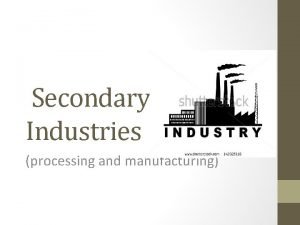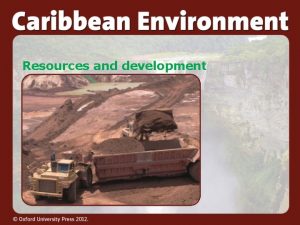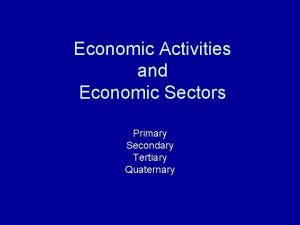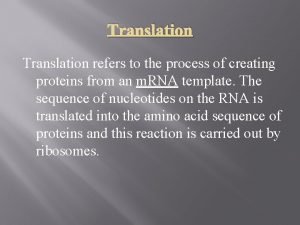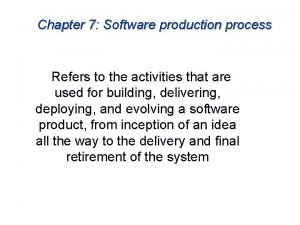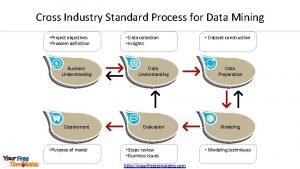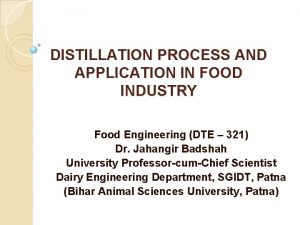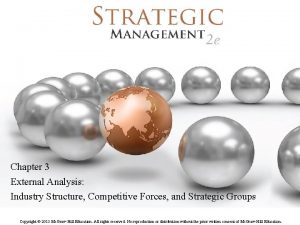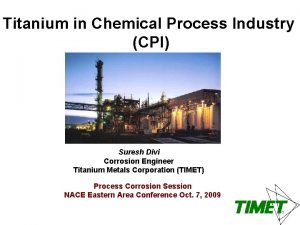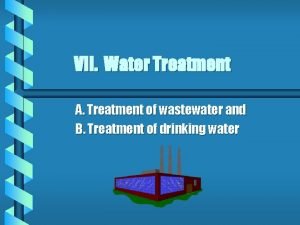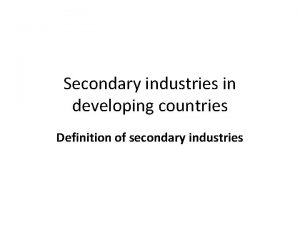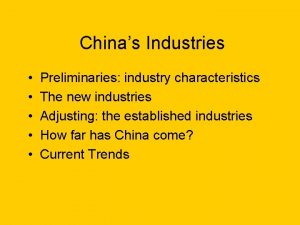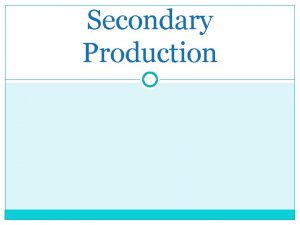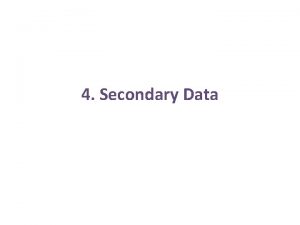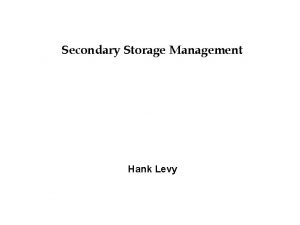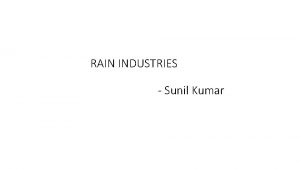LESSONV INDUSTRIES DEFINITION Secondary activitiesmanufacturing process Industry refers

















- Slides: 17

LESSON--V INDUSTRIES

DEFINITION Secondary activities-manufacturing process: Industry refers to an economic activity concerned with production of goods extraction of minerals or the provision of services.

CLASSIFICATION OF INDUSTRIES l Based on sectors. Agro – based(agro products-food processing, dairy products l Mineral based-(mineral products-iron from iron-ore l Marine-based-processing seafood from sea l Forest-based-use of forest products such as pulp and paperindustries

LARGE SCALE AND SMALL SCALE INDUSTRIES l BASED ON SIZE- Large scale and small scale Large scale : More capital, more labour force, more area. (eg): iron and steal industries. Small scale : Less capital few employeesless area (eg): garment factories.

BASED ON OWNERSHIP Ø PRIVATE SECTOR: Owned by individual (eg): Tata iron and steel. Ø PUBLIC SECTOUR: Owned by government (eg): railways. Ø JONT SECTOR: Both state and individuals (eg): Maruthi vidyog. Ø CO-OPERATIVE SECTOR: Owned by workers or owners or by both. (eg): Anand milk.

FACTORS AFFECTING LOCATION OF INDUSTRIES 1. 2. 3. 4. 5. 6. 7. 8. Availability of raw material. 2. land 3. water 4 labour Power Capital Transport and market

INDUSTRIAL SYSTEM l An industrial system consists of inputs, processes and outputs. l The inputs are the raw materials, labour and costs of land, transport, power and other infrastructure. l The outputs are the end product and the income earned from it.

INDUSTRIAL REGIONS l Major regions are; l 1. EASTERN NORTH AMERICA l WESTERN AND CENTRAL EUROPE l EASTERN EUROPE ANDEASTERN ASIA.

India- industrial regions l l l l 1. MUMBAIPUNE CLUSTER , BANGALORE TAMIL NADU REGION HUGLI REGION AHMSDABAD-BARODA REGION CHOTTANAGPUR INDUSTRIAL BELT VISHAKAPATNAM-GUNTUR BELT GURGAONDELHI MEERUT REGIONAND THE KOLLAM THIRUVANATHAPURAM INDUSTRIAL CLUSTER

DISTRIBUTION OF MAJOR INDUSTRIES--WORLD l 1. Iron and steel industries are in GERMANY, U. S. A, CHINA, JAPAN AND RUSSIA l Textile industries are in INDIA, HONGKONGSOUTH KOREA JAPAN AND TAIWAN.

TATA IRON AND STEEL COMPANY. l JAMSHEDPUR---It was started in 1907 at sakchi in Jharkhand. l TISCO has suitable factors like power supply from Jharia coal field and water supply from subarnarekha and the kharkai river and transport from Bengal-Nagpur railway line.

PITTSBURGH § STEEL CITY OF U. S. A HAS LOCATIONAL FACILITIES LIKE § 1. iron ore from minnesoto mines § 2. GREAT LAKES § 3. water way § 4. The ohil , the monogahela and allegheny rivers provides water supply. Today very few of the large steel mills are in pittsburgh itself.

COTTON TEXTILE INDUSTRIES The textile industries can be divided on the basis of raw materials used in them. India, china, Japan and u. s. a are the great producers. cotton. silk. wool, jute and other Fibres are coming under textile industries.

INDIAN TEXTILES l In INDIA Mumbai, Ahmedabad, kolkotta, coimbatore are the main centres. l Factors like warm moist climateport, raw materials skilled labour are responsible for it.

INFORMATION TECHNOLOGY l Deals in the storage processing and distribution of information. l Factors; Resource availability, cost and infrastructure. l California and bangalore are the main centres. l In india, Mumbai, delhi, Hyderabad and Chennai are the main centres.

DO YOU KNOW? l What is an industry? l Name the two main factors influence the location of industries. l Name the I. Tcentres of INDIA. l Which is called steel city of India? l Name the industrial regions of the world. l Name the two states of india known for textiles.

GOT THE ANSWERS? l GOOD . DO ALL THE TEXT BOOK EXERCISES. l l THANK l YOU
 Weight gaining industry examples
Weight gaining industry examples Secondary industry definition
Secondary industry definition Primary secondary and tertiary industries in belize
Primary secondary and tertiary industries in belize Primary secondary and tertiary industries
Primary secondary and tertiary industries Primary secondary tertiary economic activities
Primary secondary tertiary economic activities Why is socialization a lifelong process
Why is socialization a lifelong process Translation refers to
Translation refers to Process of directing
Process of directing Process refers to
Process refers to Industry analysis
Industry analysis Cross industry process for data mining
Cross industry process for data mining What is under pressing
What is under pressing Application of distillation
Application of distillation Industry convergence is a process whereby
Industry convergence is a process whereby Galvanic corrosion table
Galvanic corrosion table Knitting process in textile industry
Knitting process in textile industry By products of sugar industry
By products of sugar industry Wastewater treatment process primary secondary tertiary
Wastewater treatment process primary secondary tertiary

